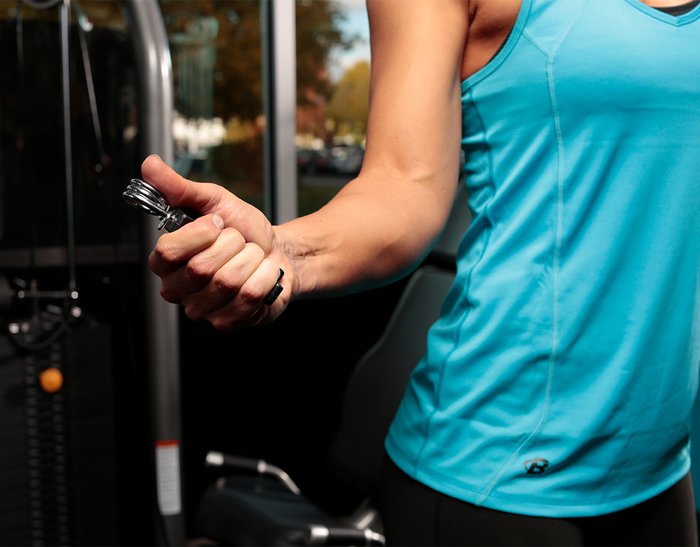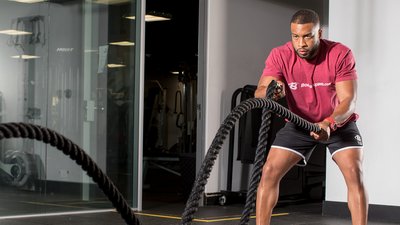Pop quiz: What's the fitness quality that is the strongest predictor of your overall health risk? No, it's not your mile time, max bench, or waist size. It's your grip strength. Believe it or not, poor grip strength is a widely accepted measure of someone's overall risk of death, especially death related to heart attack, stroke, or cardiovascular disease.[1]
In other words, the stronger your grip, the stronger you are as a whole. But grip strength isn't just a predictor of mortality risk. It's also essential when you want to carry a load of groceries from your car, test your pull-up reps, or up a deadlift PR.
"I've seen hundreds of people miss a deadlift, not because their hamstrings and back were weak, but because the bar simply slipped right out of their hands," says CJ McFarland, Onnit Academy's head strength-and-conditioning coach.
So how are you going to strengthen it? Not over using lifting straps is a great start. But you should also do some more dedicated grip-building work with these "old school" gym tools.
An Overview of Grip Strength
McFarland is quick to point out that there are three types of grip strength, and grip training. To maximize your strength potential, you need all three represented in your training somewhere.

- Crush Grip: The grip between your fingers and palm, such as what you use when shaking hands or using gripper tools.
- Pinch Grip: The grip between your fingers and thumb. Grip-focused athletes have specialized tools for this, but it also gets serious work in rock climbing and American Ninja Warrior-style challenges.
- Support Grip: Your ability to hold something for a sustained amount of time, such as holding a heavy barbell, or hanging from a pull-up bar.
Of course, thinking of these in isolated terms isn't necessarily helpful unless you have access to a full range of strongman toys. McFarland recommends using other heavy objects to train all three attributes—which will also do wonders for your core strength and shoulder health.
"If you have access to tools like kettlebells, steel maces, steel clubs, and battle ropes," McFarland says, "you can create a multitude of physiological and neurological adaptations that are tough to get with conventional tools like barbells or dumbbells. These tools allow you to train all planes of motion, increase mobility and stability in multiple joints, and develop more proprioceptive awareness."
Each of these old-school tools will no doubt feel light in your hands at first. But they promote adaptations that can give you a better chance of maximizing your PRs.
Steel Mace
The steel mace has been used for thousands of years as a way to train for fighting and military action. These long bars are unevenly weighted, with a heavy steel ball at one end. By gripping the bar farther away from the weighted ball, you're forced to work harder to control the unevenly-weighted lever.
McFarland points to steel mace single-arm pikes as an effective grip-strengthening exercise. In addition to challenging your hand, finger, and forearm strength as you slowly move the mace through a full range of motion, you'll also work your entire arm and the stabilizing muscles of your shoulder and core.
Steel Club
Steel clubs have many of the same properties as steel maces: They've been around for centuries, are unevenly weighted and, due to the imbalanced design, require greater muscular engagement to control during standard and unconventional exercises. They're also shorter, thicker, and generally easier to manage than a mace during swinging exercises, so you can work with a heavier weight.
McFarland suggests trying the steel club single-arm pull-over to improve grip strength while simultaneously working your shoulder, upper back, and core to maintain stability. But traditional exercises such as steel club "ready position" squats can enhance grip strength as you hold the club in a vertical position while performing the squat.
Kettlebell
Kettlebells are the ultimate swinging implement, requiring you to control not just the weight of the tool, but the added effect of gravity as it pulls against the bell during exercises like kettlebell swings. And while standard swings are certainly an effective way to build grip strength, they're not the only way.
"Farmer's walks are a classic training method that are amazingly simple but effective," says Richard Wilcock, a certified strength coach and owner of Flagship Fitness. "Just pick two heavy kettlebells and walk with them until you can't hold them any longer. You can do this while standing stationary, but the sway of the bells while moving adds an extra bit of difficulty."
Both Wilcock and McFarland also point to kettlebell stationary holds as an effective grip-strengthening tool, suggesting kettlebell single-arm overhead presses as a good option. When doing the exercise, hold the kettlebell handle in your hand with the bell pointing up toward the ceiling, a challenging position to maintain.
"The heavier base will want to pull the weight around in your grip, and resisting the movement takes a serious bit of forearm and grip strength," Wilcock says.
McFarland goes one step further and suggests turning the kettlebell upside down for a bottoms-up press. Not only does this encourage proper pressing mechanics, it also trains unreal crush grip strength—even with relatively light weights.
Battle Rope
Battle ropes are an excellent way to enhance power, core strength, and cardiovascular capacity. They're also incredibly good at improving grip strength, because you have to hold on tight to swing and control the ropes. And at least as far as battle ropes go, size matters.
"The thicker the rope, the harder it is to maintaining your grip," Wilcock says. "It's one of the best old-school training exercises for grip endurance."
Of course, you can't go wrong with quick, powerful battle rope waves. Wilcock says that done correctly, each wave physically tries to pull the rope forward, out of your hands.
Looking for an even greater grip—and back and biceps—challenge? Try heavy rope pulls. Simply tie a heavy weight to the far end of the rope, sit with your back to a wall, and pull the weight toward you using only your arms. The heavier the weight, the harder the exercise.
References
- Leong, D. P., Teo, K. K., Rangarajan, S., Lopez-Jaramillo, P., Avezum, A., Orlandini, A., ... & Rahman, O. (2015). Prognostic value of grip strength: findings from the Prospective Urban Rural Epidemiology (PURE) study. The Lancet, 386(9990), 266-273.

